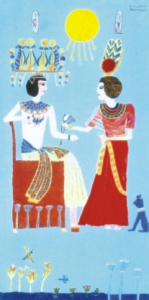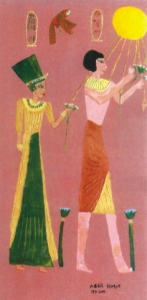|
Art
The Boy Wonder
Mustafa Zaman
Autistic children are a mystery to the people who surround them. Parents of such children who suffer from this developmental disorder marked by the difficulty to communicate often find themselves in a difficult situation. But one mother who made a breakthrough in helping her autistic child to find an outlet for all the energy is Leedy Hoque, the mother of Aadil Hoque, the painter.
In Aadil's second solo exhibition, his mother reflects on how he became interested in having an exhibition in the Bengal Gallery of Fine Arts premises. "In one particular day in December 2002, Aadil was restless. He did not quite settle at school and I couldn't take him anywhere, so we decided to visit the Bengal Gallery of Fine Arts. This was Aadil's first visit to a gallery in Bangladesh. There was a show on by sculptor Hamiduzzaman, and Aadil was transfixed. He started giving his own title to each piece he confronted," remembers Leedy. As soon as they got back home the first thing he said was that he wanted an exhibition at Bengal Gallery, and then he asked for clay. Clay was brought for him "and he worked with clay the whole night", remembers his mother. "He came up with a whole array of imitations of Hamiduzzaman's sculptures. The visit to the exhibition really fired him up," recalls Leedy.

Day and Night in Ancient Egypt: Wedding of Cleopatra and Mark Antony
Although these clay sculptures are not showcased in the second solo of this prolific artist, there is a particular piece, an acrylic on canvas, which pays homage to the sculptor Hamiduzzaman. In this smallish work Aadil puts two figures of the sculptor side by side -- one that depicts the sculptor at work and the other that can be seen as an attempt to capture the portraiture. There are other portraitures in this exhibition. When he was contemplating the show at Bengal Gallery, Aadil made a list of the names he was later to explore through paint and brush. Among his favourites were Rabinthranath Tagore, Shakespear, and Shelly. Sir David Attenborough also found his place among the names that Aadil favoured. He was exposed to a TV documentary where Attenborough set out on a journey to know the
 |
Tutankhamun and Ankhesemamun |
origin of an artifact he bought. The journey ends in Easter Island, famous for its giant stone statues. It is here that Attenborough discovers that the wooden figure he bought was of Meke Meke, the most important god, the creator of the world. Later on a trip to the Pitt Rivers Museum in Oxford with his teacher Judy Holdsworth and his mother, Aadil wanted to see the Easter Island wooden figure and the staff were able to produce a similar figure to his amazement. In Aadil's portraiture of Attenborough he is seen holding the figure. If portraiture as a subject that stimulates Aadil and makes him wants to try a good likeness, it is ancient themes that really bring out the best in him. Aadil's large canvases that depict the panoramic visions culled from Egyptian epics are the ones that still exude the most artistic verve. The painting titled "Day and Night in Ancient Egypt: Wedding of Cleopetra and Mark Antony," a huge oil on canvas, is among the most peopled canvases of this painter. This is where his fascination for ancient Egypt finds an appropriate expression.
There are other medium-sized canvases painted using the acrylic colour where Aadil's flare for well-defined outline and well-modulated colour in perfect imitation of Egyptian murals find an outlet. It is the above tendencies that gave the present show its gems.
The show titled "Devotion" will also be remembered for the watercolour pieces. Colours become brighter and the treatment fluid in these smallish works that mostly explore the theme of love. As in the last solo there are expressionistic oil pieces that marry the Egyptian theme with the gesture of brush strokes and colour patches. There are ten paintings from the last solo that finally ended up on the walls of Bengal Gallery; the rest were done since the last show in 2002.
Aadil has turned 16 on December 13, this year. He has come a long way, and the journey was not as smooth as it now may seem.
It all began when he was only seven. Aadil's mother came across this book titled "Son Rise, the Miracle Continues" and that led her on a course to a breakthrough. "Aadil was taken to the Option Institute in Massachusetts, an organisation for autistic children that was founded on the success that is depicted in the book," attests Leedy. What she was exposed to in that institute in the next couple of weeks is a "child-centred approach" in dealing with her autistic child. What it did for Aadil was that it helped him re-orientate his cognitive world. "He developed the capability of verbal communication for the first time," Leedy testifies.
 |
| William Shakespeare at the Globe Theatre |
Once back in Oxford, it is with the help of Social Service and the Oxford Education Authority that the home-based educational and therapeutic programme fashioned after the programe initiated by the people at Option Institute began from September 1996. The programme stoked Aadil's imagination. He was fascinated by Egypt and his mother along with his teachers constantly provided him with the necessary stimulations. "It was when we were browsing through Children Atlas of World History that he was first introduced to ancient civilisations. The next day he uttered, 'Egypt', and then he said, 'museum', and from that point on Aadil's journey began," remembers Leedy.
Aadil's mother started amassing books on Egypt. "His room was turned into a museum of sorts," she recalls. Aadil started talking and besides his study he began to draw. His first attempts were on magnetic drawing board on which anything can be drawn and wiped out to accommodate the next drawing. In his drawings the Egyptian mythic characters figured. He even had a birthday cake in the shape of a pyramid in December 13, 1996, his seventh birthday. All these activities on his part, along with the stimulations that he constantly received, made him more organised in his behaviour. "His lego construction got better," remembers Leedy.
By the time he was nine he participated in a group show in Oxford where other autistic children submitted their entries. In 2000 Aadil's mother decided to come back home. "The family -- his father -- was in Dhaka. I along with Aadil and one of his sisters went on to live in Oxford with Aadil's welfare in mind. So, we came back and it hasn't been as bad as many had envisaged," says Leedy. She understands that there are limitations as far as resources are concerned, but as a whole Aadil's artistic journey has not been interrupted.
 |
William Shakespeare at the Globe Theatre |
On the contrary the two exhibitions, one in 2002 and the one that ended recently at the Bengal Gallery, are proof that his long stay in Dhaka has not been fruitless. While in Bangladesh Aadil's inexorable energy to delve into anything Egyptian has not seen any flagging. On the last day of the show, Aadil was in a slightly hyper mode. Amidst his paintings and the shawls of visitors that crowd the gallery, he was visibly excited. He kept coming back to his mother to know whether the children in Dhaka listened to Mozart or not. He is a fan. He has been thoroughly exposed to Western classical music as well as Tagore songs. They have been his companions in his journey; they have enriched his world.
His artistic endeavour too brought him a reward that not only pickled his young mind but also boosted the morale of the person who had been indefatigable in her effort to rear Aadil, his mother Leedy Hoque. Aadil received the gold medal in 2005 for his depiction of Cleopatra in the international exhibition titled, "Egypt in the Eyes of the World's Children," organised by the Egyptian Ministry of Culture.
A lot can be accounted for the success of Aadil, but the foremost concern, as his mother puts it, is "acceptance". With all the experience that she had been through, Leedy has a clear vision for any child with autism; she believes that once the child is accepted in the mainstream and is given adequate support change is bound to take place. She is now contemplating the prospect of helping other autistic children by setting up an advisory. As for Aadil he has already expressed his wishes to his mother for having a book on his art. After two solo exhibitions a book can only happen if the family finds financial support from any organisation that would be willing to patronise the art of a child about whose working of the mind we have little knowledge.
Copyright
(R) thedailystar.net 2005 |
